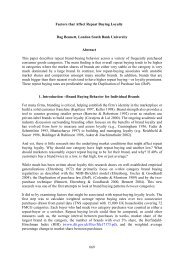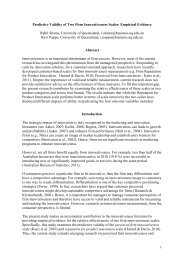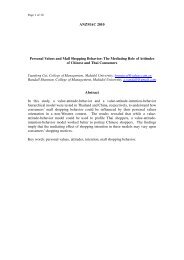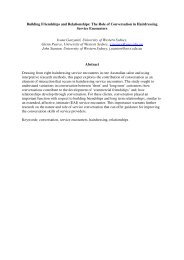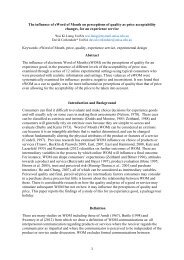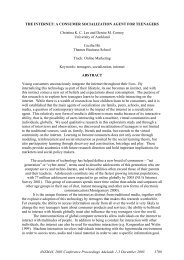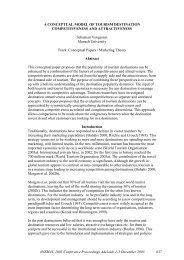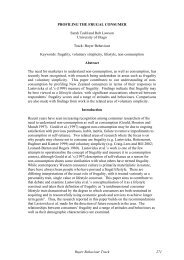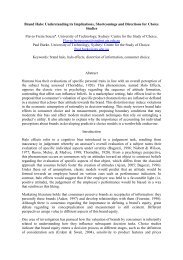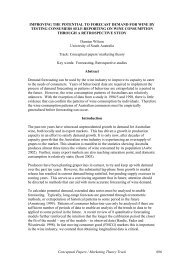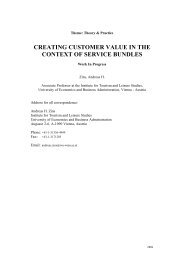Using Structural Equation Modeling for Success Factor ... - ANZMAC
Using Structural Equation Modeling for Success Factor ... - ANZMAC
Using Structural Equation Modeling for Success Factor ... - ANZMAC
You also want an ePaper? Increase the reach of your titles
YUMPU automatically turns print PDFs into web optimized ePapers that Google loves.
implications <strong>for</strong> researchers. One implication <strong>for</strong> a <strong>for</strong>mative specification is that deleting one<br />
indicator could omit a unique part of the measurement model and change the domain meaning<br />
of the construct (Diamantopoulos and Winklhofer, 2001). Thus, some researchers state that a<br />
<strong>for</strong>mative measurement model requires a census of all indicators that determine the construct<br />
(Bollen and Lennox 1991). Often <strong>for</strong>mative indicators do not follow a multinormal distribution.<br />
Social research often leads to nonnormal item distribution curves, with varying degrees<br />
of skewness and kurtosis which can strongly influence the choice of SEM estimator (Browne,<br />
1984). Two main approaches have been used to estimate <strong>for</strong>mative measurement models in<br />
SEM: the partial least squares (PLS) and the covariance-based (CBSEM) methods. However,<br />
little attention has been devoted to the conditions in which <strong>for</strong>mative measures and their estimation<br />
method leads to precise and robust coefficients. This study is one of the first consisting<br />
of primarily <strong>for</strong>mative variables.<br />
There are several CBSEM estimators available <strong>for</strong> analyst choice. Estimation methods include:<br />
Unweighted Least Squares (ULS), Generalized Least Squares (GLS), Maximum Likelihood<br />
(ML) and Asymptotic Distribution Free (ADF) estimation (Marcoulides and Hershberger,<br />
1997). This paper focuses on ML estimation. The inclusion of <strong>for</strong>mative measures in<br />
CBSEM is well documented by Jöreskog and Sörbom (2001) and MacCallum and Brown<br />
(1993). (Diamantopoulos 2006) recently outlined pertinent issues in <strong>for</strong>mative CBSEM identification<br />
which also supplements the work of Kline (2006) ii . Wilson, Callaghan and Stain<strong>for</strong>th<br />
(2007) instigated these suggestions in a Confirmatory Vanishing Tetrad Analysis paper.<br />
In contrast, the goal of PLS estimation is to maximise the variance of all dependent variables.<br />
There<strong>for</strong>e, the goal of PLS and CBSEM is inherently different in estimation and purpose<br />
(Chin, 1995). However, Rigdon (2003) explains that PLS is often a nontraditional alternative<br />
when undertaking analyses. PLS estimates become more accurate as PLS claims to operate on<br />
the assumption of “consistency at large” (Fornell and Cha, 1994). Whilst PLS typically overestimates<br />
structural parameters and underestimates loadings Rigdon (2003, p. 1935) states<br />
“that this is a reasonable trade….to estimate essentially hypothetical model parameters <strong>for</strong> an<br />
improved ability to predict the data.”<br />
The Vilares, Almeida, and Coelho (2007) study comes the closest to a PLS Monte Carlo investigation<br />
featuring one <strong>for</strong>mative construct specification with the balance of constructs in<br />
their research being a reflective orientation. Their scenarios include: a symmetric base model<br />
and one with skewed data. They also use as the basis <strong>for</strong> their work the reduced <strong>for</strong>m of the<br />
European Customer Satisfaction Index (ECSI) model stating that debate exists about whether<br />
the loyalty construct is best represented by reflective or <strong>for</strong>mative indicators. They generate<br />
1000 simulated datasets <strong>for</strong> 250 observations <strong>for</strong> 21 measured variables. (Chin; Marcolin, and<br />
Newstead 2003)) and Hsu, Chen, and Hsieh (2006) both complete simulation studies but they<br />
only focus on constructs with reflective specifications. Some studies ((Fornell and Bookstein<br />
1982); Lohmöller, 1989; Tenenhaus et al., 2005) iii have CBSEM (ML estimation) and PLS estimation<br />
comparisons but these were not <strong>for</strong> Monte Carlo studies.<br />
Formative models have been prevalent within business and marketing success factor research<br />
(c.f., Lee and Tsang, 2001; Höck and Ringle, 2006; Wixom and Watson, 2001). These indicators<br />
are usually independent drivers of the success factor. The model we specify is also similar<br />
to models that have been studied <strong>for</strong> ECSI investigations (Gronholdt, Martensen and Kristensen,<br />
2000; Kristensen, Martensen and Gronholdt, 2000). Many studies of this nature typically<br />
have response profiles that do not meet the normality assumption.<br />
831



